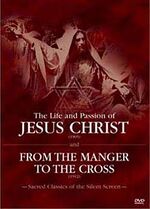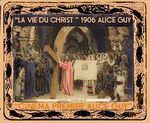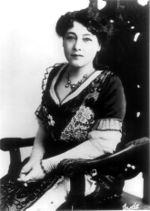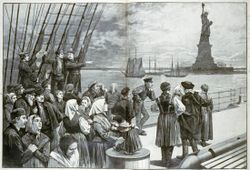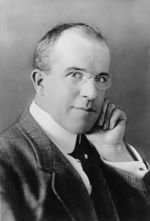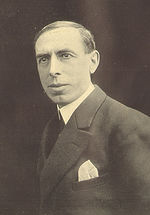Difference between revisions of "Category:Cinema--1900s"
| (3 intermediate revisions by the same user not shown) | |||
| Line 12: | Line 12: | ||
The page: '''Cinema--1900s''', includes (in chronological order) literary works of [[Cinema]], made in the 1900s, or from 1900 to 1909. | The page: '''Cinema--1900s''', includes (in chronological order) literary works of [[Cinema]], made in the [[1900s]], or from 1900 to 1909. | ||
[[File:Jesus Film Zecca.jpg|thumb|150px|[[La vie et la passion de Jésus-Christ (The Life and Passion of Jesus Christ / 1903 Zecca, Nonguet), feature film]]]] | [[File:Jesus Film Zecca.jpg|thumb|150px|[[La vie et la passion de Jésus-Christ (The Life and Passion of Jesus Christ / 1903 Zecca, Nonguet), feature film]]]] | ||
[[File:Jesus Film Guy2.jpg|thumb|150px|[[La naissance, la vie et la mort de N.-S. Jésus-Christ (The Birth, the Life and the Death of Christ / 1906 Guy-Blaché), film]]]] | [[File:Jesus Film Guy2.jpg|thumb|150px|[[La naissance, la vie et la mort de N.-S. Jésus-Christ (The Birth, the Life and the Death of Christ / 1906 Guy-Blaché), film]]]] | ||
[[File:Alice Guy-Blaché.jpg|thumb|150px|[[Alice Guy-Blaché]]]] | [[File:Alice Guy-Blaché.jpg|thumb|150px|[[Alice Guy-Blaché]]]] | ||
* [[Fiction (1900s)]] -- [[Art (1900s)]] | |||
* [[Dance (1900s)]] -- [[Literature (1900s)]] | |||
* [[Music (1900s)]] -- [[Theatre (1900s)]] | |||
}} | |||
{{WindowMain | {{WindowMain | ||
| Line 33: | Line 39: | ||
{{WindowMain | {{WindowMain | ||
|title= | |title= [[Interpreters]] ([[1900s]]) | ||
|backgroundLogo= Bluebg_rounded_croped.png | |backgroundLogo= Bluebg_rounded_croped.png | ||
|logo = | |logo = contents.png | ||
|px= 38 | |px= 38 | ||
|content= | |content= | ||
}} | }} | ||
| Line 59: | Line 57: | ||
|logo= history.png | |logo= history.png | ||
|px= 38 | |px= 38 | ||
|content= [[File: | |content= [[File:1900s.jpg|thumb|left|250px]] | ||
'''''[[Cinema]]''''' : [[:Category:Cinema--2020s|2020s]] -- [[:Category:Cinema--2010s|2010s]] -- [[:Category:Cinema--2000s|2000s]] -- [[:Category:Cinema--1990s|1990s]] -- [[:Category:Cinema--1980s|1980s]] -- [[:Category:Cinema--1970s|1970s]] -- [[:Category:Cinema--1960s|1960s]] -- [[:Category:Cinema--1950s|1950s]] -- [[:Category:Cinema--1940s|1940s]] -- [[:Category:Cinema--1930s|1930s]] -- [[:Category:Cinema--1920s|1920s]] -- [[:Category:Cinema--1910s|1910s]] -- [[:Category:Cinema--1900s|1900s]] -- [[:Category:Cinema--1850s|1850s]] | |||
''[[ | '''''[[Fiction]]''''' : [[:Category:Fiction--2020s|2020s]] -- [[:Category:Fiction--2010s|2010s]] -- [[:Category:Fiction--2000s|2000s]] -- [[:Category:Fiction--1990s|1990s]] -- [[:Category:Fiction--1980s|1980s]] -- [[:Category:Fiction--1970s|1970s]] -- [[:Category:Fiction--1960s|1960s]] -- [[:Category:Fiction--1950s|1950s]] -- [[:Category:Fiction--1940s|1940s]] -- [[:Category:Fiction--1930s|1930s]] -- [[:Category:Fiction--1920s|1920s]] -- [[:Category:Fiction--1910s|1910s]] -- [[:Category:Fiction--1900s|1900s]] -- [[:Category:Fiction--1850s|1850s]] -- [[:Category:Fiction--1800s|1800s]] -- [[:Category:Fiction--1700s|1700s]] -- [[:Category:Fiction--1600s|1600s]] -- [[:Category:Fiction--1500s|1500s]] -- [[:Category:Fiction--1450s|1450s]] -- [[Fiction|Home]] | ||
'''''[[Timeline]]''''' : [[2020s]] -- [[2010s]] -- [[2000s]] -- [[1990s]] -- [[1980s]] -- [[1970s]] -- [[1960s]] -- [[1950s]] -- [[1940s]] -- [[1930s]] -- [[1920s]] -- [[1910s]] -- [[1900s]] -- [[1850s]] -- [[1800s]] -- [[1700s]] -- [[1600s]] -- [[1500s]] -- [[1450s]] -- [[Medieval]] -- [[Timeline|Home]] | |||
}} | |||
{{WindowMain | |||
|title= Languages | |||
|backgroundLogo= Bluebg_rounded_croped.png | |||
|logo= contents.png | |||
|px= 38 | |||
|content= [[File:Languages.jpg|thumb|left|250px]] | |||
'''''[[Cinema]]''''' : [[:Category:Cinema--English|English]] -- [[:Category:Cinema--French|French]] -- [[:Category:Cinema--German|German]] -- [[:Category:Cinema--Italian|Italian]] -- [[:Category:Cinema--Spanish|Spanish]] -/- [[Fiction|Other]] | |||
'''''[[Fiction]]''''' : [[:Category:Fiction--English|English]] -- [[:Category:Fiction--French|French]] -- [[:Category:Fiction--German|German]] -- [[:Category:Fiction--Italian|Italian]] -- [[:Category:Fiction--Spanish|Spanish]] -/- [[Fiction|Other]] | |||
}} | }} | ||
[[File:J. Stuart Blackton.jpg|thumb|left|150px|[[J. Stuart Blackton]]]] | [[File:J. Stuart Blackton.jpg|thumb|left|150px|[[J. Stuart Blackton]]]] | ||
|} | |} | ||
|} | |} | ||
== History of Research ([[1900s]]) -- Notes == | |||
[[File:Ferdinand Zecca.jpg|thumb|150px|[[Ferdinand Zecca]]]] | |||
[[File:Luigi Maggio.jpg|thumb|150px|[[Luigi Maggi]]]] | |||
While the first "biblical" films all focused on the figure of Jesus, in the 1900s the interest expanded to include the life of the first Christians, following the success of novels like "The Last Days of Pompeii", ''Quo vadis?'', and ''The Sign of the Cross''. Subjects like the [[Wandering Jew]], [[Ben-Hur]], [[Salome]] and [[Spartacus]] offered a glimpse to the Jewish and Greco-Roman backgrounds of the New Testament. [[Solomon]], [[David]] and [[Moses]] were the first Old Testament characters to attract the attention of filmmakers. | |||
Also from the technical point of view the 1900s saw some major improvement. Following the format of ''The Horitz Passion Play'' (1897), ''Soldiers of the Cross'' (1900) was a "feature film" only because a series of slides, moving pictures and music were included to accompany and illustrate the preaching of [[Herbert Booth]]. In the following years, the first proto-features were produced in the USA and France, by releasing a series of individual (short film) scenes, leaving the exhibitor the option of playing them alone, an incomplete combination of some, or running them all together as a feature film. The American company S. Lubin released a Passion Play (Titled: Lubin's Passion Play) in January 1903 in 31 parts, totaling about 60 minutes. The French company Pathé Frères released a different Passion Play, The Life and Passion of Jesus Christ, in May 1903 in 32 parts running about 44 minutes. | |||
While following the same episodical format, ''La naissance, la vie et la mort de N.-S. Jésus-Christ'' (1906) by [[Alice Guy-Blaché]] marked a major shift. It parted from the traditional iconographical approach of the first Jesus movies, following the new Oriental fashion introduced by the work of [[James Tissot]]. Orientalism became the distinctive style of all ''biblical'' films, including the first feature film on the Hebrew Bible, ''The Life of Moses'' (1909) by [[J. Stuart Blackton]], which also was made of a series of five episodes originally released as independent short films. | |||
@2015 [[Gabriele Boccaccini]], University of Michigan | |||
Latest revision as of 16:00, 6 December 2019
History of Research (1900s) -- Notes
While the first "biblical" films all focused on the figure of Jesus, in the 1900s the interest expanded to include the life of the first Christians, following the success of novels like "The Last Days of Pompeii", Quo vadis?, and The Sign of the Cross. Subjects like the Wandering Jew, Ben-Hur, Salome and Spartacus offered a glimpse to the Jewish and Greco-Roman backgrounds of the New Testament. Solomon, David and Moses were the first Old Testament characters to attract the attention of filmmakers.
Also from the technical point of view the 1900s saw some major improvement. Following the format of The Horitz Passion Play (1897), Soldiers of the Cross (1900) was a "feature film" only because a series of slides, moving pictures and music were included to accompany and illustrate the preaching of Herbert Booth. In the following years, the first proto-features were produced in the USA and France, by releasing a series of individual (short film) scenes, leaving the exhibitor the option of playing them alone, an incomplete combination of some, or running them all together as a feature film. The American company S. Lubin released a Passion Play (Titled: Lubin's Passion Play) in January 1903 in 31 parts, totaling about 60 minutes. The French company Pathé Frères released a different Passion Play, The Life and Passion of Jesus Christ, in May 1903 in 32 parts running about 44 minutes.
While following the same episodical format, La naissance, la vie et la mort de N.-S. Jésus-Christ (1906) by Alice Guy-Blaché marked a major shift. It parted from the traditional iconographical approach of the first Jesus movies, following the new Oriental fashion introduced by the work of James Tissot. Orientalism became the distinctive style of all biblical films, including the first feature film on the Hebrew Bible, The Life of Moses (1909) by J. Stuart Blackton, which also was made of a series of five episodes originally released as independent short films.
@2015 Gabriele Boccaccini, University of Michigan
Pages in category "Cinema--1900s"
The following 36 pages are in this category, out of 36 total.
1
- The Last Days of Pompeii (1900 Booth), short film
- Passione di Gesù (Passion of Jesus / 1900 Cristofari, Topi), short film
- Soldiers of the Cross (1900 Perry), film (es) AUS
- Quo Vadis? (1901 Zecca, Nonguet), short film
- The Passion Play Series (1903 Lubin), feature film
- La vie et la passion de Jésus-Christ (The Life and Passion of Jesus Christ / 1903 Zecca, Nonguet), feature film
- The Sign of the Cross (1904 Haggar), short film
- Le juif errant (The Wandering Jew / 1904 Méliès), short film
- La naissance, la vie et la mort de N.-S. Jésus-Christ (The Birth, the Life and the Death of Christ / 1906 Guy-Blaché), feature film
- Tanz der Salome (Salome's Dance / 1906 Messter), short film
- If You Had a Wife Like This (1907 Biograph), short film
- Giuditta e Oloferne (Judith and Holophernes / 1907 Caserini), short film
- Salome (1907 Gaumont), short film
- Salome (1907 Lubin), short film
- Ben-Hur (1907 Olcott), short film
- Salome; or, The Dance of Seven Veils (1908 Blackton), short film
- Salomé (1908 Capellani), short film
- Judith et Holopherne (Judith and Holophernes / 1908 Feuillade), short film
- L'inconsciente Salomé (Salome / 1908 Feuillade), short film
- Gli ultimi giorni di Pompei (The Last Days of Pompeii / 1908 Maggi, Ambrosio), short film
- Nero and the Burning of Rome (1908 Porter), short film
- The Great Salome Dance (1908 Tyler), short film
- Saul and David (1909 Blackton), short film
- The Judgment of Solomon (1909 Blackton), short film
- The Life of Moses (1909 Blackton), feature film
- Spartaco (Spartacus / 1909 Gherardini), short film
- La légende du Juif errant (The Legend of the Wandering Jew / 1909 Jasset), short film
- Martire pompeiana (Martyrs of Pompeii / 1909 Liguoro), short film
- Nerone (Nero / 1909 Maggi), short film
Media in category "Cinema--1900s"
This category contains only the following file.
- 1909 Bour (film).jpg 220 × 286; 17 KB

